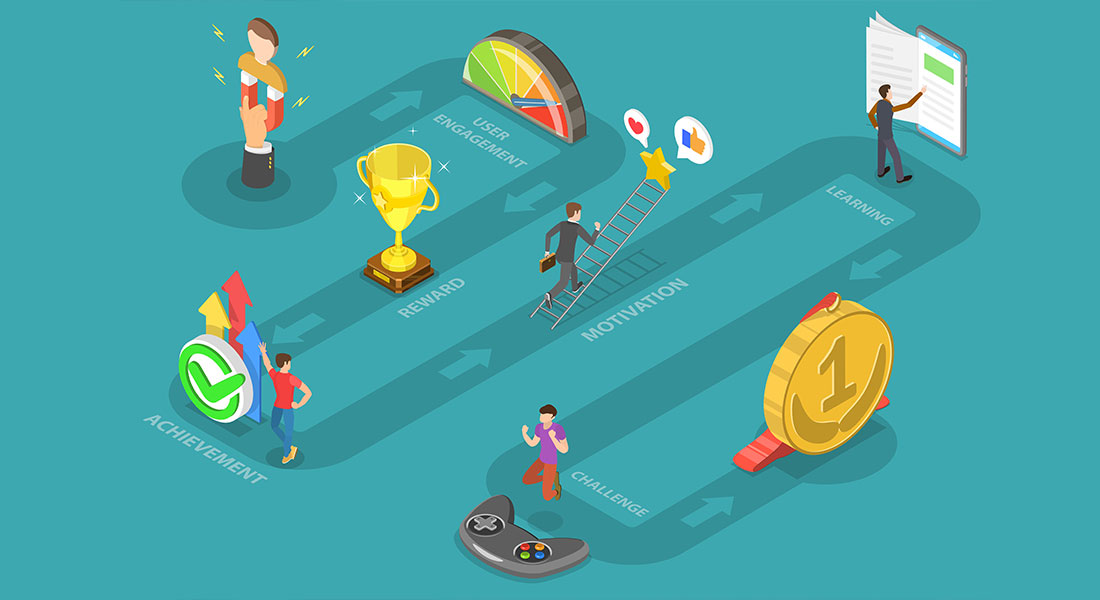How to Offset Employee Disengagement Through Gamification?
Level up engagement and motivation with gamification in your organization. Learn the cast spell of setting goals, feedback, and analysis.

Imagine a workplace, where employees are happy to come in day in and day out, eagerly finish their tasks with a smile, and feel extremely motivated and energized. Sounds like a dream, doesn’t it? Well, it’s a lot easier to turn this dream into a reality. Organizations can unleash the scientifically proven method of gamification to help them achieve these goals. In this article, we will discuss, at length, some of the top ways to offset any disengagement employees might be feeling by gamifying their workflows. So, grab your virtual weapon, put your game face on, and prepare to unlock the treasure chest filled with gamification tips and tricks.
How Can Gamification be Your Ally in the Battle Against Employee Disengagement?
Incorporating gamified training elements can offer host of benefits, such as:
- Enhanced employee engagement
- Increased motivation and productivity
- Improved enjoyment and satisfaction in training
Understanding Employee Disengagement
Before we set off on an adventure to understand how gamification can be helpful in defeating our enemy, let us take a moment to understand what exactly it is. Employee disengagement: imagine a stealthy leech-like monster that slowly but steadily drains away the morale, positivity, and spirit of employees and renders them unproductive. Employee disengagement has multiple forms. It can manifest itself in employees who feel stuck in their current roles. It can turn itself into an amorphous fog in which employees find themselves when they lose purpose.
It might strike if the employees feel disconnected from the mission of the organization and feel discordance between the company’s output and their own individual contributions. It might whisper negative thoughts if employees feel unappreciated or face lack of constructive feedback. It thrives on miscommunication. It tricks the employees into feeling that their voices will not be heard, and the organization failing to communicate important updates and changes only fuels the fire.
Power of Gamification in Boosting Employee Engagement
The task that falls on L&D professionals in the organization is to restore hope and bring the disengaged employees back to the light side of the force. One innovative and fun way to do this is through gamification.

Gamification has been empirically proven to be a formidable tool against the battle with disengagement. A study by Talentlms found that 89% of the employees surveyed feel that they would feel more engaged in their workplaces if there were gamified activities. Furthermore, the study also stated that 83% of those who receive gamified corporate training felt motivated, while the 61% who received non-gamified training sessions tend to feel bored and unproductive.
Integration of gamification elements, such as leaderboards, challenges, quests, badges, and points, in corporate training has proven to make the work as well as training more enjoyable for employees. This increases their excitement towards taking part in gamified activities – a striking blow to our opponent. Converting ‘must-do’ tasks into games taps into intrinsic motivation of the employees, wherein achieving a goal takes on a whole new and more complete meaning in their minds.
Tips on Using Gamification to Offset Employee Disengagement

Define Clear Goals and Objectives for Gamification Implementation
Organizational leadership, along with L&D heads, should specify their goals and objectives up front before employing gamification tactics. Setting explicit and measurable objectives assures alignment and success, whether the goal is strengthening team cooperation, fostering learning and development, or enhancing employee performance. For instance, the gamification experience could concentrate on tests, leaderboards, and prizes based on right answers if the objective is to improve product knowledge.
→ Download Now: Instructional Design 101
Design Relevant Gamification Experiences
Gamification experiences should be pertinent and significant to employees’ work contexts in order to maximize engagement. For instance, if the goal is to promote cooperation, a gamified platform that motivates staff to collaborate on projects and pays them for their accomplishments as a group might be quite successful.
Integrate Gamification Elements in Existing Processes
Gamification components should be seamlessly incorporated into current training procedures to provide a smooth transition and increased adoption rates. The important touchpoints within planned training sessions, where gamification can be implemented, should be identified. For instance, adding game elements to learning management systems can increase engagement and motivate staff to take part. Eager to start implementing gamification in your current training process? Watch this short video that will help you get started.
Facilitate Recognition
Maintaining employee motivation and engagement requires regular feedback and acknowledgment. Gamification in learning recognizes employees’ accomplishments and progress. Organizations can promote a good and inspiring work atmosphere by implementing components like virtual badges, level advancements, or personalized messages of praise.
Foster Collaboration and Healthy Competition
While gamification can be used to promote healthy competition, it is essential to be mindful that it doesn’t give rise to unhealthy and unnecessarily competitive environments. Gamification can be used to encourage teamwork and constructive competition among workers. Gamified learning environments should promote cooperation, knowledge sharing, and healthy competition. To encourage healthy competition while promoting a sense of camaraderie and teamwork, team challenges or leaderboards that showcase top performance might be implemented.
Analyze the Impact of Gamification and Redesign the Strategy
Gamification strategies must be continually assessed and analyzed to determine their impact and efficacy. To evaluate employee satisfaction, performance enhancements, and levels of engagement, the training managers should collect data and feedback. The gamification approach can be improved and redesigned considering the findings to fill any gaps or add features that meet the changing needs of the workforce.
Summing Up
And there you have it! Armed with the information about nooks and crannies of insidious employee disengagement, L&D professionals can make a positive impact, using the power of gamification. They can reignite the spark among their teammates, allow them to clearly see their value, enable them to polish their skills, strengthen their powers, and challenge their limitations. Gamification elements can be incorporated in corporate training processes by defining clear goals and designing relevant experiences for maximum engagement. Want to discover how to create engaging eLearning courses with gamification? Download our handy reference guide to know more.





